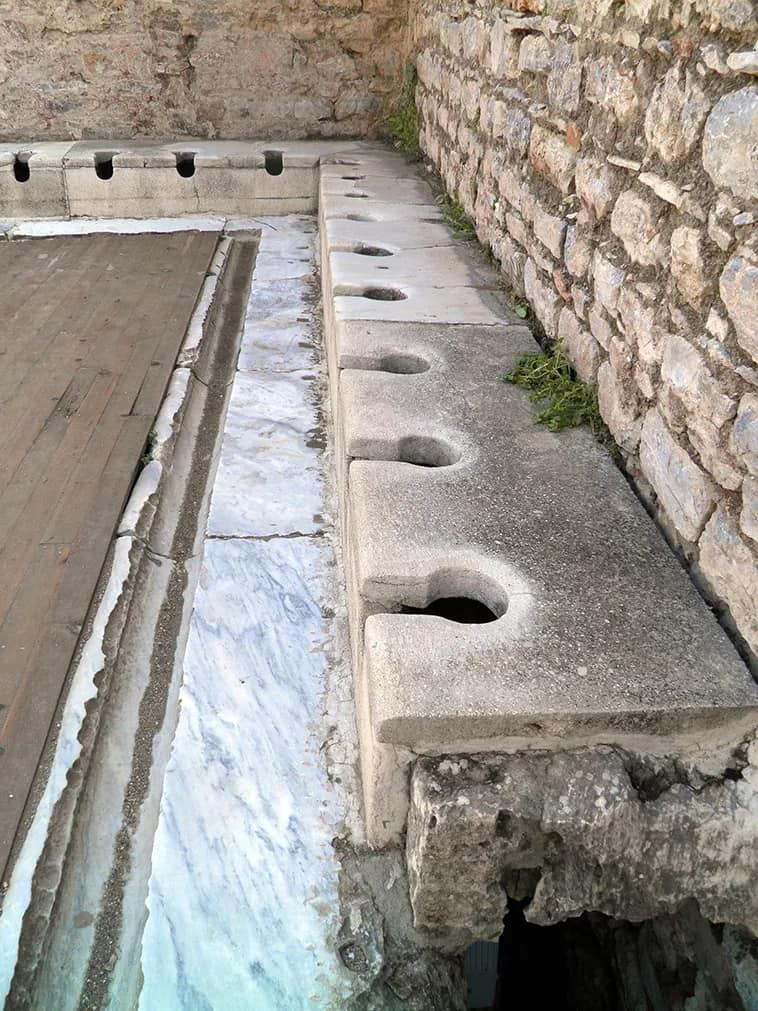The ancient Romans are often regarded as pioneers in engineering, architecture, and public health. Among their many innovations was the sophisticated system of public latrines, which exemplified their commitment to hygiene, urban planning, and even social integration. The Roman approach to sanitation reveals not only their advanced engineering skills but also their unique social dynamics, offering a fascinating glimpse into how hygiene was interwoven with daily life in the empire.
Hygiene and Infrastructure: A Marvel of Engineering
The Roman Empire was known for its impressive infrastructure, and public sanitation was a crucial part of this. By the 4th century CE, Rome boasted 144 public latrines (foricae), designed to accommodate a large number of citizens. These latrines were an important aspect of Roman urban life, providing access to sanitation in both public and private spaces. While wealthy Roman homes often had private toilets connected to aqueduct systems, the majority of the population relied on communal latrines.
Roman public latrines were designed as long galleries with rows of seats made of marble, arranged at close intervals to maximize space. These galleries could accommodate 10 to 20 people at a time, making the act of relieving oneself a social, and sometimes even a communal, activity. The engineering of these latrines was sophisticated, often incorporating water channels that flushed waste away, drawing fresh water from aqueducts. The Romans’ ability to maintain public health through such systems was revolutionary, especially when compared to the more unsanitary practices of later historical periods, such as the Middle Ages.

Hygiene Practices: The Roman Approach to Cleanliness
Romans were particularly innovative in their approach to hygiene. Instead of using paper, they employed natural sponges (spongia) attached to sticks, known as xylospongium or tersorium. These sponges were soaked in water (often mixed with vinegar for disinfection) and reused by multiple individuals. After use, the sponges were rinsed and returned to bowls of water. This system, while unusual by modern standards, was effective for maintaining hygiene, given the communal nature of Roman society.
The floors of Roman latrines typically had small channels that carried fresh water, sourced from aqueducts, to cleanse the facilities. This continuous flow of water helped maintain a level of cleanliness and prevent the spread of disease. The proximity of latrines to bathhouses further reinforced the Romans’ holistic approach to public hygiene, creating spaces where individuals could cleanse themselves physically and maintain a level of social harmony.
Human Interaction and Social Integration: The Role of Communal Latrines
The public latrines of ancient Rome were not only a technological and hygienic marvel but also a reflection of the social fabric of Roman society. The communal nature of the latrines meant that they were shared by people of all classes, from the poorest citizens to the wealthiest patricians. This shared space highlighted the egalitarian aspect of Roman sanitation, where the needs of the body were not differentiated by social rank.
Latrines were often free to use, making them an accessible resource for the general population. For the lower classes, public latrines provided a more structured and hygienic alternative to disposing of waste in the streets or open drains, a practice sometimes seen in more impoverished areas. In this sense, the Roman latrine system was a reflection of both the empire’s concern for public health and its social dynamics, where even the most basic human needs were managed with a degree of order and sophistication.

Historical and Cultural Significance: From Practicality to Symbolism
Roman public latrines also held symbolic significance. The very design and placement of these structures often carried cultural and historical meaning. Some public latrines were located near important public spaces, such as bathhouses, marketplaces, and theatres, reinforcing the integration of hygiene into daily Roman life. However, certain latrines became associated with notable historical events.
For example, the Theatre of Pompey, where Julius Caesar was famously assassinated in 44 BCE, later had its portico turned into a public latrine. This transformation was a striking example of how the Romans repurposed spaces over time, even those marked by significant historical events. The change from a place of political intrigue and murder to one of communal relief underscores the pragmatic and sometimes ironic way the Romans dealt with history and space.
The Legacy of Roman Sanitation: A Lasting Influence
The Roman system of public latrines was not only a testament to their engineering prowess but also a reflection of their sophisticated social order. These latrines were an essential part of Roman cities, offering a glimpse into the daily lives of its citizens, their approach to public health, and their social structures. The communal nature of these latrines, their advanced engineering, and their role in maintaining public hygiene left a lasting legacy that influenced sanitation practices for centuries.
In the centuries following the fall of the Roman Empire, many of these innovations were lost or forgotten. It wasn’t until the late medieval period that Europe saw a resurgence in the development of public hygiene systems. In this way, the Roman latrine system can be viewed as a precursor to modern sanitation and a key component of the Roman legacy that continues to inspire the design of public hygiene systems today.
In conclusion, the public latrines of ancient Rome were more than just functional spaces—they were symbols of Roman ingenuity, social integration, and their commitment to public health. From their advanced engineering to their cultural significance, these latrines played a key role in shaping Roman society and left a legacy that would influence future generations.
